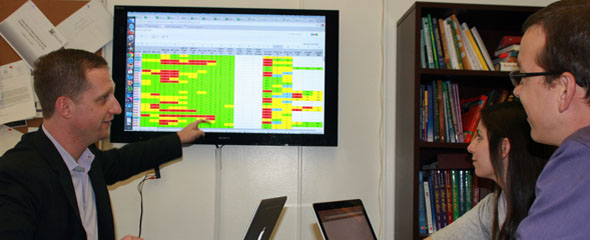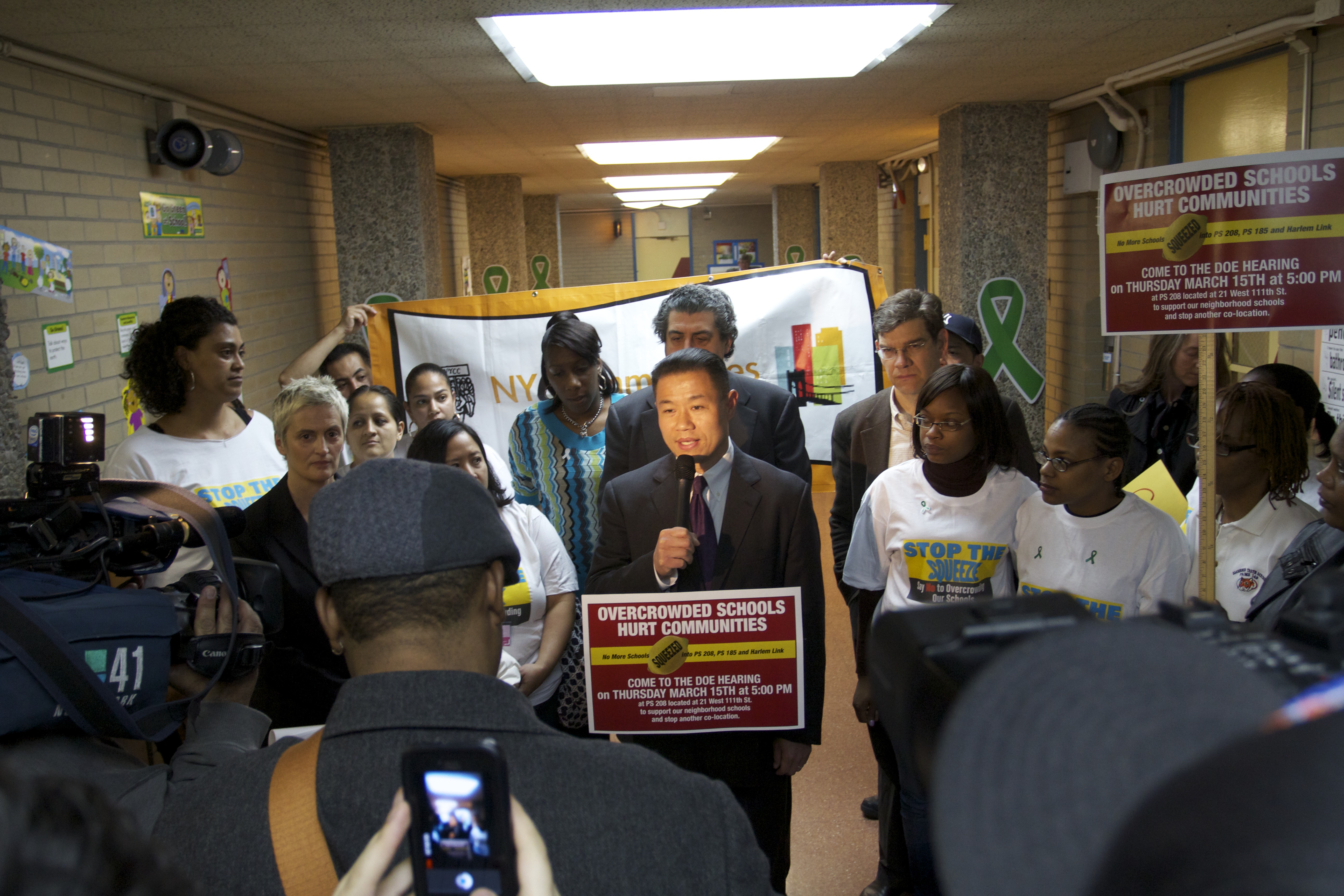
When Jeremy Matuk requires tutoring for any of his students, he fills out a form with a free Google application. At the Academy for Careers in Television and Film, a Long Island City, Queens, public school where Matuk teaches 10th grade social studies, that simple action immediately sets off a series of events. It creates tutoring sessions and reminders in his and his students’ online calendars. It notifies the student’s teacher advisor. It logs the information in a centralized spreadsheet. It creates a tutoring contract as PDF that is sent to Matuk, the student and their advisor.
Thus is life in an automated school.
Principal Mark Dunetz vowed to streamline some of the things that make most schools inefficient when he opened the Academy for Careers in Television and Film four years ago.
The tutoring program was one of them. Every school has one. And teachers need to be compensated for tutoring overtime. But not every school has a way to analyze the input and output for those hours. Dunetz decided to run his trade school for filmmaking, directing and lighting design using free Google apps.
“Overtime is tracked in the payroll system,” Dunetz said. “And it’s in a payroll system that doesn’t give you information back in any format that allows you to analyze it.”
With Dunetz’s system, teachers like Matuk can pull up a spreadsheet that tells him whether students have been showing up for their tutoring sessions. He can even adjust the spreadsheet to compare students’ classroom grades with their tutoring sessions. If one of his students misses a session with another teacher, he automatically receives a notification.
A system like this is important in a school that depends on advisory, a program where one teacher mentors a group of students even if they don’t teach them. That means they need a way to keep close tabs on student grades, attendance, tutoring and other activities. Dunetz is always adding to the system, extending it to include attendance and student work. Dunetz can automatically pull up different drafts of essays for various classes.
“Almost every aspect of what we do is on some Google Doc at this point,” said Matuk, a five-year teacher who previously taught social studies at Thomas Edison High School in Queens. “In conferences with parents it becomes so valuable that I can pull up all this evidence of student progress.”
For Dunetz, efficiency is one of the unique aspects of his school. His task was to build a specialized school curriculum on a regular New York City public school budget. His program included providing vocational training in shooting and producing films that required $400,000 of technology not found in other schools. The school also paid to convert an old locker room into a film studio. That’s when Dunetz decided to target inefficiencies using Google’s free cloud software so that he could maintain a leaner staff.
The Academy for Careers in Television and Film has around 300 students, no deans, only one secretary, and its social worker also acts as the guidance counselor. Dunetz notes that he saves money by employing less staff, but “we’re still doing stuff that other schools would never have time to do.”
But by knowing advanced excel formulas and java script, Dunetz can automate things like tutoring and attendance that would require more staff to keep track of, or might just get lost in the shuffle in most schools.
Data keeping is nothing new for New York City public schools. Since Mayor Bloomberg started the Department of Education in 2002, data has been a major focus. Schools often buy and switch data software like Datacation or Galaxy, in addition to keeping grades through the Department of Education’s Gradebook system.
But according to Sueng Yu, the proposed school leader for the highly touted Academy For Software Development, prepackaged data systems aren’t flexible.
“It’s much more of a generic program or software,” said Yu, referring to Datacation, which he used at his previous school. “In some ways you have to customize the school to the software.”
Dunetz can customize Google automations to his school. He creates scripts and tracking systems for whatever problems pop-up. As Yu lays the groundwork for the Academy for Software Engineering, he’s been working with ACTvF to adapt Dunetz’s systems to his school.
Since schoolwide software can also run into the thousands of dollars, Yu is happy that it will not break the school’s budget. “Anytime you can get resources free of charge that are extremely useful, I’d be amiss if I didn’t take advantage of that,” he said.
Teachers at ACTvF admit that it puts a lot on their plate. “The only flaw in the system is that it really does depend on everybody buying in,” said teacher Jeremy Matuk. He said that at first it wasn’t easy to remember to record tutoring sessions, daily interactions and meetings with students.
“In the beginning it was about, ‘Wow, now I have to do 50 more things,’” said Matuk. “But now it’s about reaping the benefits of that system.”
ACTvF math teacher Ariel Lindorff said that it took a lot to adapt to the system. “I’m not the most organized person when it comes to these systems and it feels like a lot at times, but it’s a really simple thing to do,” she said, referring to logging notes and hours for tutoring.
But it has produced results at the Academy for Careers in Television and Film, including increased attendance and parent satisfaction. Assistant principal Edgar Rodriguez said that the real impact is seen when you view 8th grade attendance rates versus attendance at his school.
“It’s a big difference,” said Rodriguez. “You see kids who had barely came to school in 8th grade who completely change their behavior here.” Every time ACTvF’s secretary records an unexcused absence in the Google system, automatic emails are sent to advisers and teachers, who immediately email or call parents.
Students end up viewing teachers as nearly omniscient, since every teacher seems to know when they’ve been late or absent, or have skipped tutoring.
“Teachers here know what’s going on about you,” said sophomore Melissa Marrero, who wakes up at 5:00 a.m. every day to receive tutoring from Jeremy Matuk. Marrero never received tutoring at her old public school in Coney Island, Brooklyn, where she lives, despite moving there from Puerto Rico in 8th grade and needing ESL services. She said teachers just couldn’t keep track of students at her old school to even know who needed it.
But at ACTvF teachers seem to know even small details. “Attendance is important here,” said Marrero. “I know teachers really keep up with it. Even if you’re only five minutes late.”
Recently, Dunetz has decided to partner with 15 other schools in New York City who are interested in using his model and formulas. His goal is to change the way principals think about their jobs. He said that while it is important to develop an excellent curriculum, it’s equally important to develop efficient ways to communicate across the school so that the curriculum can be developed further.
“A principal needs to take seriously questions like, how is email distributed within my school community?” said Dunetz. “We have to stop seeing that as a question that is divorced from curriculum development because, in fact, those are the tools that we use to communicate effectively to develop new curriculum.”



Is there any way you can share how these apps were created? I am a public school lead teacher, and I have used Google Docs to create my own lesson plan template. https://docs.google.com/spreadsheet/viewform?pli=1&formkey=dGFZSVlxbldIWjd3TERMdjdqUU9zNXc6MA#gid=0
It can be printed as a plan, but when I save the plan it goes to a spreadsheet, which compiles the lesson plans for easy recording and comparison.
So, my request for more information is not out of the blue. I really want to know how this works so that I could come up with other ideas to make our teaching lives (and learning opportunities) more productive.
Thanks.
I just took my nephew to Open House ACTvF last night. He will be attending in the fall. He is looking forward to learning and meeting new friends who share their love for movies and what goes on behind the camera. The staff and students seem to have an energy I don’t remember seeing at my high school. Good luck to the students and this barely four year old school.
For schools interested in some of the “add on” functionality that ACTvF uses with Google Forms and Spreadsheets to run automated emails, merged Docs, etc. see New Visions’ YouPD.org, where a few of them are documented with screencasts. The two scripts most in use at ACTvF are the autoCrat – http://www.youpd.org/autocrat and the formMule – http://www.youpd.org/formmule Also check out the recently released Doctopus script for managing student projects in Docs – http://www.youpd.org/doctopus
Schools need a variety of tools to support the important work they are doing especially when it comes to capturing, organizing, and monitoring student data. Software products including DataCation and Google Apps are both effective tools to help schools meet their goals and to ultimately improve student performance. I recommend that schools find the product/tool that best fits their needs, which is why the Academy for Software Engineering is using both DataCation and Google Apps. Schools should explore a variety of products to establish the critical systems needed to foster overall school success.
Perfect for lesson plans. Glad that Google made this kind of applications. Helps us to make our life get more easier. It’s true that schools should find ways to discover new applications that could help them improve their performance in teaching.
I do tutoring myself.This is a great application for organizing your work and your lessons between teacher and student.It’s easier to manage and you can do real time reporting and putting infos real time.You can also do it even if the student is at his/her home and youre also at your home.Very reliable,convenient,you can maximize your work time.Just love it.